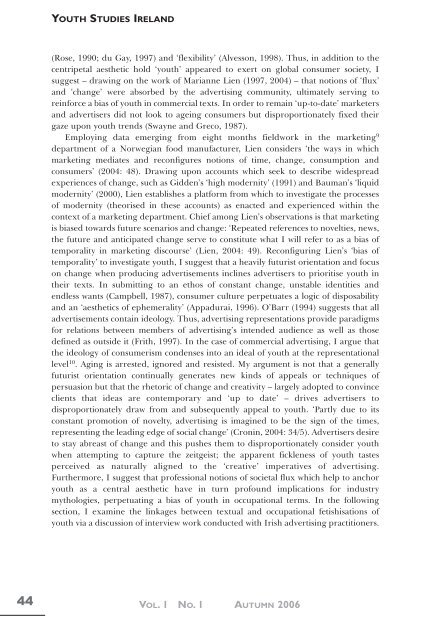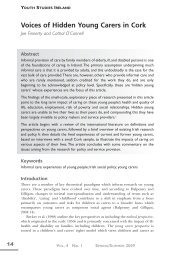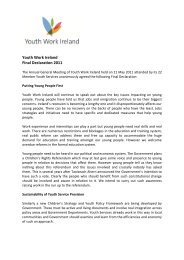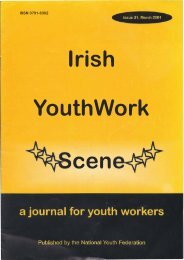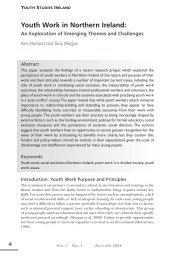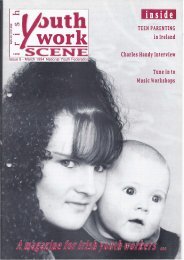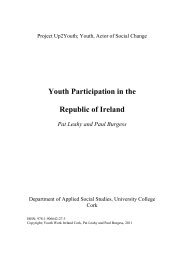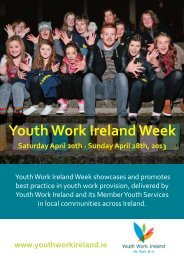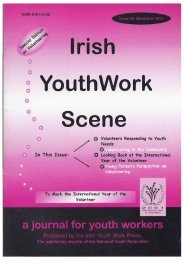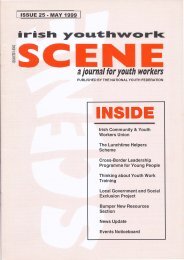YOUTH STUDIES IRELAND(Rose, 1990; du Gay, 1997) and ‘flexibility’ (Alvesson, 1998). Thus, in addition to thecentripetal aesthetic hold ‘youth’ appeared to exert on global consumer society, Isuggest – drawing on the work of Marianne Lien (1997, 2004) – that notions of ‘flux’and ‘change’ were absorbed by the advertising community, ultimately serving toreinforce a bias of youth in commercial texts. In order to remain ‘up-to-date’ marketersand advertisers did not look to ageing consumers but disproportionately fixed theirgaze upon youth trends (Swayne and Greco, 1987).Employing data emerging from eight months fieldwork in the marketing 9department of a Norwegian food manufacturer, Lien considers ‘the ways in whichmarketing mediates and reconfigures notions of time, change, consumption andconsumers’ (2004: 48). Drawing upon accounts which seek to describe widespreadexperiences of change, such as Gidden’s ‘high modernity’ (1991) and Bauman’s ‘liquidmodernity’ (2000), Lien establishes a platform from which to investigate the processesof modernity (theorised in these accounts) as enacted and experienced within thecontext of a marketing department. Chief among Lien’s observations is that marketingis biased towards future scenarios and change: ‘Repeated references to novelties, news,the future and anticipated change serve to constitute what I will refer to as a bias oftemporality in marketing discourse’ (Lien, 2004: 49). Reconfiguring Lien’s ‘bias oftemporality’ to investigate youth, I suggest that a heavily futurist orientation and focuson change when producing advertisements inclines advertisers to prioritise youth intheir texts. In submitting to an ethos of constant change, unstable identities andendless wants (Campbell, 1987), consumer culture perpetuates a logic of disposabilityand an ‘aesthetics of ephemerality’ (Appadurai, 1996). O’Barr (1994) suggests that alladvertisements contain ideology. Thus, advertising representations provide paradigmsfor relations between members of advertising’s intended audience as well as thosedefined as outside it (Frith, 1997). In the case of commercial advertising, I argue thatthe ideology of consumerism condenses into an ideal of youth at the representationallevel 10 . Aging is arrested, ignored and resisted. My argument is not that a generallyfuturist orientation continually generates new kinds of appeals or techniques ofpersuasion but that the rhetoric of change and creativity – largely adopted to convinceclients that ideas are contemporary and ‘up to date’ – drives advertisers todisproportionately draw from and subsequently appeal to youth. ‘Partly due to itsconstant promotion of novelty, advertising is imagined to be the sign of the times,representing the leading edge of social change’ (Cronin, 2004: 34/5). Advertisers desireto stay abreast of change and this pushes them to disproportionately consider youthwhen attempting to capture the zeitgeist; the apparent fickleness of youth tastesperceived as naturally aligned to the ‘creative’ imperatives of advertising.Furthermore, I suggest that professional notions of societal flux which help to anchoryouth as a central aesthetic have in turn profound implications for industrymythologies, perpetuating a bias of youth in occupational terms. In the followingsection, I examine the linkages between textual and occupational fetishisations ofyouth via a discussion of interview work conducted with Irish advertising practitioners.44 VOL. 1 NO. 1 AUTUMN 2006
Addressing <strong>Youth</strong> and Being YoungThe ‘Occupational’ Bias of <strong>Youth</strong> in AdvertisingOne visiting an ad agency is always taken by the youth of its staff…ours is anoccupation for the young (Kover, 1977: 36).Carrigan and Szmigin (2003) suggest that advertising generally excludes older people (inrepresentational terms) in favour of the youth market. In accounting for this bias, Isuggested (above) that an explanation demands consideration of many factors, but is likelyto include the following: a conception of youth as the pulse of modernity; the perceivedaesthetic and creative potentiality afforded by youth appeals and themes; a demonstrableinclination on the part of youth to invest financially and emotionally in advertising derived,in part, from a putative insecurity and openness of identity; and an apparent synergy oraffinity between global brands and ‘universal’ youth culture. In this section, however, I wishto examine a second (occupational) manifestation of the bias of youth, drawing fromsubstantive studies of practitioners in advertising as well as incorporating some qualitativeinterview data deriving from my own research. While the empirical data included here istaken directly from interviews with Irish practitioners (using initials for the purposes ofconfidentiality and anonymity), the views expressed should be interpreted within the widerindustry context discussed in the previous section.However explained, it would appear that advertising has long been regarded ‘abusiness in which youth has a special kind of moral advantage’ (Tunstall, 1964: 17).Even today, Tunstall’s description appears to hold true. Denise DeMars, director ofhuman resources and worldwide compensation director for Foote Cone & Belding inthe United States, recently commented: ‘We have a higher [percentage of] GenerationX in our demographics than the typical labour force’ (quoted in Noe, 2005: 28).Similarly, Mahoney (2004: 46), drawing on Bureau of Labour Statistics figures,suggests that more than fifty nine percent of employees in the UK advertising industryare between the ages of twenty-five and forty-four. Unfortunately, there are no similarfigures currently available from the Central Statistics Office (CSO) or the Institute ofAdvertising Practitioners of <strong>Ireland</strong> (IAPI). Nevertheless, my own findings offer somesupport to the proposition that ‘advertising is a young person’s industry’ (Powell, 2000:212). While commentators and journalists (such as Mahoney above) argue that what Ihave termed an ‘occupational’ bias of youth operates in advertising, an adequateexplanation for why this is so is markedly absent in these accounts. Bird (1993: 330),for example, blandly states that ‘the challenge and variety of work in the agenciesappeal more to young people’. I want to suggest, in line with Cronin (2004), thatadvertising is constituted via ‘circuits of belief ’ that flow between practitioners, clients,regulators, consumers and academics. In doing so, I will suggest that several of theabovementioned factors that can be used to explain the ‘textual’ bias of youth are alsoimplicated in a corresponding ‘occupational’ bias. (In the language of ‘discourseanalysis’, the metaphors and descriptions under the following headings might bedescribed as ‘interpretative repertoires’ 11 .)45
- Page 2: YOUTH STUDIES IRELANDEditorial‘Yo
- Page 5 and 6: Youth Work in Northern IrelandStruc
- Page 8: YOUTH STUDIES IRELANDThese principl
- Page 11 and 12: Youth Work in Northern IrelandMany
- Page 13 and 14: Youth Work in Northern Irelandthe d
- Page 15 and 16: Youth Work in Northern IrelandA fur
- Page 17 and 18: Youth Work in Northern IrelandAckno
- Page 19 and 20: YOUTH STUDIES IRELANDYouth, Governa
- Page 21 and 22: Youth, Governance and the Citycommu
- Page 23 and 24: Youth, Governance and the Cityor be
- Page 25 and 26: Youth, Governance and the Cityunemp
- Page 27 and 28: Youth, Governance and the CityCase
- Page 29 and 30: Youth, Governance and the CityIn mo
- Page 31 and 32: Youth, Governance and the CityConcl
- Page 33 and 34: Youth, Governance and the City11 Ta
- Page 35 and 36: Youth, Governance and the CityBreat
- Page 37 and 38: Youth, Governance and the CityKelli
- Page 39 and 40: Youth, Governance and the CityWhela
- Page 41 and 42: Addressing Youth and Being Youngpro
- Page 43: Addressing Youth and Being YoungWit
- Page 47 and 48: Addressing Youth and Being Young‘
- Page 49 and 50: Addressing Youth and Being Youngdra
- Page 51 and 52: Addressing Youth and Being Youngwhe
- Page 53 and 54: Addressing Youth and Being Youngwho
- Page 55 and 56: Addressing Youth and Being Young12
- Page 57 and 58: Addressing Youth and Being YoungDe
- Page 59 and 60: Addressing Youth and Being YoungMcW
- Page 61 and 62: YOUTH STUDIES IRELANDASBOs and Beha
- Page 63 and 64: ASBOS and Behaviour Orders: Institu
- Page 65 and 66: ASBOS and Behaviour Orders: Institu
- Page 67 and 68: ASBOS and Behaviour Orders: Institu
- Page 69 and 70: ASBOS and Behaviour Orders: Institu
- Page 71 and 72: ASBOS and Behaviour Orders: Institu
- Page 73 and 74: ASBOS and Behaviour Orders: Institu
- Page 75 and 76: ASBOS and Behaviour Orders: Institu
- Page 77 and 78: YOUTH STUDIES IRELANDTraveller Chil
- Page 79 and 80: Traveller Children and Education: P
- Page 81 and 82: Traveller Children and Education: P
- Page 83 and 84: Traveller Children and Education: P
- Page 85 and 86: Traveller Children and Education: P
- Page 87 and 88: Traveller Children and Education: P
- Page 89 and 90: Traveller Children and Education: P
- Page 91 and 92: Traveller Children and Education: P
- Page 93 and 94: Review ArticleReview ArticleSignifi
- Page 95 and 96:
Review Articleis Social Care?’ an
- Page 97 and 98:
Review ArticleShort Note on a Funda
- Page 99 and 100:
ReviewReviewYouth Work Liaison Foru
- Page 101 and 102:
Reviewdevelopments in areas related
- Page 103 and 104:
103


